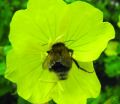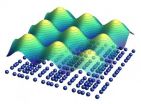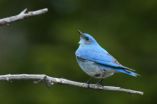(Press-News.org) Most people are not aware of the fact that 84% of the European crops are partially or entirely dependent on insect pollination. While managed honeybees pollinate certain crops, wild bees, flies and wasps cover a very broad spectrum of plants, and thus are considered the most important pollinators in Europe.
The serious decline in the number of managed honeybees and wild bees reported in Europe over the last few decades has the potential to cause yield decreases with threats to the environment and economy of Europe. The future of the pollination services provided by bees is therefore of serious concern. Effective actions for the mitigation of the pollinator declines need to be taken across Europe.
Although honeybees are important pollinators in large scale plantations, for some crops, including sunflowers, a combination of wild bees and honeybees are essential to provide optimal pollination. Wild bees can support farm productivity when the honeybees can't do the work, for example when their number is insufficient, or when weather conditions prevent them from flying. Moreover, it is well known for several crops, that wild bees are more efficient at pollinating than honeybees, such as mason bees on apples and bumblebees on beans. In addition, wild bees can be a lower cost alternative to honeybees since they do not need to be rented commercially if sufficient high quality pollinator habitat is available in and around farms.
To raise awareness among farmers for the importance of wild pollinators, the EC FP7 project STEP – 'Status and Trends of European Pollinators' published a farmers' factsheet in 15 European languages. The factsheet encourages farmers to utilize the benefits of wild insect pollination services, and thus reduce the risks of relying on the honeybee as a single species for crop production. Farmers are encouraged to take actions to protect pollinators by selecting appropriate agri-environmental schemes and modifying agricultural practices to become more pollinator friendly.
Simultaneously, STEP is undertaking a broad-scale survey of the public opinion through online questionnaires available in seven European languages. The survey aims to reveal if, and to what extent, people are aware of the role of pollinators in agricultural ecosystems and the consequences for the environment from the decline of bees and other insect pollinators. People are also being asked to give their opinion on the importance of insect pollination for agriculture to share their perception on the status of pollinators in Europe, their importance for public health, wildlife and the European economy and how important they believe this issue to be. Readers of all nationalities are invited to express their opinions through this online survey.
INFORMATION:
Additional Information:
STEP project is funded by the European Commission within the FP 7, grant No. 244090 – STEP– CP – FP. More information can be found at: www.step-project.net
Posted by Pensoft Publishers.
Wild pollinators support farm productivity and stabilize yield
2012-08-17
ELSE PRESS RELEASES FROM THIS DATE:
War is not necessarily the cause of post-traumatic stress disorder
2012-08-17
A large-scale survey of the mental condition of military personnel before, during and after their posting to Afghanistan has proved thought-provoking. In total, 746 Danish soldiers took part in the survey. The soldiers completed a questionnaire five times in all – before their posting, during their time in Afghanistan and three times after their return to Denmark.
Professor Dorthe Berntsen of the Center on Autobiographical Memory Research – CON AMORE, Department of Psychology, Aarhus University, Business and Social Sciences, is responsible for the study, together with ...
Photographic cholesterol test
2012-08-17
Researchers in India have developed a total cholesterol test that uses a digital camera to take a snapshot of the back of the patient's hand rather than a blood sample. The image obtained is cropped and compared with images in a database for known cholesterol levels.
Writing in the International Journal of Medical Engineering and Informatics, N.R. Shanker of the Sree Sastha Institute of Engineering and Technology and colleagues describe how they have developed a non-invasive way to test cholesterol levels in patients at increased risk of heart disease. Their approach ...
Regions vary in paying prisoners to participate in research
2012-08-17
TORONTO, Aug. 17, 2012--When members of the public participate in research studies, they are often given incentives – such as cash or gift cards for food – as compensation or reimbursement for their time and effort. Not so for Canada's prison population. A new analysis shows that there is inconsistency in how and when incentives are used for research participants under criminal justice supervision.
Of the provinces, territories and federal government, only two jurisdictions have written policy around the use of research incentives, according to a national study led by ...
Constructive conflict in the superconductor
2012-08-17
Whether a material conducts electricity without losses is not least a question of the right temperature. In future it may be possible to make a more reliable prediction for high-temperature superconductors. These materials lose their resistance if they are cooled with liquid nitrogen, which is relatively easy to handle. An international team, in which physicists of the Max Planck Institute for Solid State Research in Stuttgart played a crucial role, has now discovered that this form of superconductivity competes with charge density waves, i.e. with a periodically fluctuating ...
A urine based 'potion' can act as a CO2 absorbent
2012-08-17
VIDEO:
A Spanish researcher has proposed human, agricultural and livestock waste, such as urine, as a way to absorb CO2.
Click here for more information.
The ocean, the ground, rocks and trees act as carbon drains but are far from places where greenhouses gases are concentrated, especially CO2. A Spanish researcher has proposed human, agricultural and livestock waste, such as urine, as a way to absorb this gas.
Absorbing the large quantities of carbon dioxide and other greenhouse ...
2 new owls discovered in the Philippines
2012-08-17
EAST LANSING, Mich. --- Two new species of owls have been discovered in the Philippines, and a Michigan State University researcher played a key role in confirming their existence.
The discovery, which is featured in the current issue of Forktail, the Journal of Asian Ornithology, took years to confirm, but it was well worth the effort, said the paper's lead author Pam Rasmussen, MSU assistant professor of zoology and assistant curator of mammalogy and ornithology at the MSU Museum.
"More than 15 years ago, we realized that new subspecies of Ninox hawk-owls existed ...
MIT-developed 'microthrusters' could propel small satellites
2012-08-17
CAMBRIDGE, MA -- A penny-sized rocket thruster may soon power the smallest satellites in space.
The device, designed by Paulo Lozano, an associate professor of aeronautics and astronautics at MIT, bears little resemblance to today's bulky satellite engines, which are laden with valves, pipes and heavy propellant tanks. Instead, Lozano's design is a flat, compact square — much like a computer chip — covered with 500 microscopic tips that, when stimulated with voltage, emit tiny beams of ions. Together, the array of spiky tips creates a small puff of charged particles that ...
Writing the book in DNA
2012-08-17
Although George Church's next book doesn't hit the shelves until Oct. 2, it has already passed an enviable benchmark: 70 billion copies—roughly triple the sum of the top 100 books of all time.
And they fit on your thumbnail.
That's because Church, the Robert Winthrop Professor of Genetics at Harvard Medical School and a founding core faculty member of the Wyss Institute for Biomedical Engineering at Harvard University, and his team encoded the book, Regenesis: How Synthetic Biology Will Reinvent Nature and Ourselves, in DNA, which they then read and copied.
Biology's ...
NASA sees wind shear affecting Tropical Storm Gordon
2012-08-17
NASA's Terra satellite passed over Tropical Storm Gordon as it continues to spin up in the North central Atlantic Ocean, and revealed the storm has become less symmetric, indicating it is being battered by wind shear.
When Terra passed over Gordon on August 16, 2012 at 10:25 a.m. EDT (1425 UTC) the Moderate Resolution Imaging Spectroradiometer (MODIS) instrument captured a visible image of the storm. The image showed that the bulk of Gordon's clouds were pushed to the north and northeast as a result of southwesterly wind shear. The MODIS image showed what appeared to ...
Studies shed light on why species stay or go in response to climate change
2012-08-17
Berkeley — Two new studies by scientists at the University of California, Berkeley, provide a clearer picture of why some species move in response to climate change, and where they go.
One study, published online Monday, Aug. 6, in the journal Global Change Biology, finds that changes in precipitation have been underappreciated as a factor in driving bird species out of their normal range. In the other study, published today (Wednesday, Aug. 15) in the journal Proceedings of the Royal Society B, researchers found a sharp decrease in range for the Belding's ground squirrel, ...




